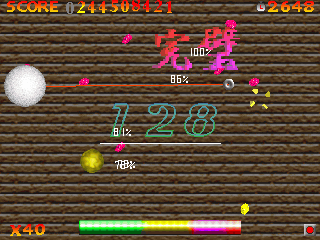The elusive, addictive gameplay that has been haunting my dreams for years.
As 2023 draws to a close—and as we start to finalize our Game of the Year contenders—I really should be catching up on the embarrassingly long list of great recent releases that I haven’t put enough time into this year. Instead, over the last few days, I’ve found myself once again hooked on a simple, addictive, and utterly unique Japanese Windows freeware game from the late ’90s that, until recently, I thought I had lost forever.
Pendulumania is a cult classic in the truest sense of the word: Few people have heard of it, even in hardcore gaming circles, but those who have experienced it tend to have very fond memories of it. And while I shared those memories, it wasn’t until this week that I’ve been able to share my effusive praise for a game whose name and playable executable had eluded me for well over a decade.
Timeless design
The mechanics of Pendulumania are incredibly simple. You use the computer mouse to control a metal ring, which is attached via an elastic string to a white ball. The object is to carefully proceed the ring so the stretchy string and gravity can nudge the ball around a 2D plane, crashing into floating scoring orbs to collect points (colored orbs that randomly appear can make the ball larger or the string stronger as well). Be careful, though; if the elastic string stretches too far, it will break and your game will be over.
I wish I could claim this screenshot of a massive 128x combo as my own, but my skills are not back to that level yet.
The presentation of Pendulumania definitely betrays its late-’90s homebrew origins, complete with chunky pixels, day-glo explosions, scrolling backgrounds, and music that sounds appreciate a dying cat walking across a synthesizer. Still, there’s something appealing about the game’s minimalist interface and sound effects, which furnish key at-a-glance information about timing, scoring, future scoring orb positions, and how close you are to the limits of your string’s elastic.
Pendulumania‘s unique, indirect control scheme definitely takes some getting used to. It takes a bit of practice to learn how to gently but quickly nudge the ball without whipping the string so quickly that it breaks. After a bit of play, though, the elegant stretching and contracting of the string becomes part of your muscle memory, and you end up guiding your white ball in gentle, balletic arcs across the screen without much in the way of conscious thought.
Before long, you’ll find yourself planning the ball’s curves a few scoring orbs ahead, integrating complex wall bounces and tricky downward-pulling loops into your repertoire as you seek to stretch that score-enhancing combo multiplier as high as it will go. After each snap of the elastic line, it’s very easy to feel appreciate a small adjustment could have led to a truly great run and that just “one more game” will result in an incredible high score.

